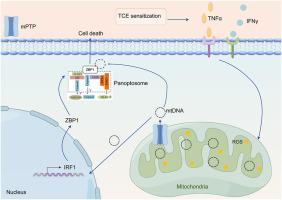MPTP控制mtDNA的释放,诱导三氯乙烯致免疫肾损伤内皮细胞PANoptosis
IF 4.7
3区 医学
Q1 PHARMACOLOGY & PHARMACY
引用次数: 0
摘要
血管内皮细胞(ECs)损伤与肾损伤密切相关。我们之前的研究揭示了干扰素调节因子1 (IRF1)介导的肾内皮细胞PANoptosis参与三氯乙烯(TCE)诱导的免疫肾损伤。然而,IRF1如何调控ECs PANoptosis仍不清楚。本研究通过引入tce致敏小鼠模型、体外实验和群体研究,探讨肾内皮细胞PANoptosis的机制。我们发现血清肿瘤坏死因子α (TNF-α)和干扰素γ (IFN-γ)与三氯乙烷(OMDT)引起的职业性药物样皮炎患者的肾脏和内皮细胞损伤有关。TNF-α和IFN-γ联合作用影响人脐静脉内皮细胞(HUVECs)线粒体通透性过渡孔(mPTP)的开放,从而促进线粒体活性氧(mtROS)和线粒体DNA (mtDNA)的释放。通过应用环孢素A (CsA)抑制mPTP开放导致细胞质mtDNA释放减少,随后细胞PANoptosis减少。CsA不仅能减轻肾损害,还能抑制肾内皮细胞PANoptosis,抑制IRF1和z -核酸结合蛋白1 (ZBP1)的表达。抑制IRF1可减轻细胞PANoptosis,而同时过表达ZBP1可挽救PANoptosis。综上所述,TNF-α联合IFN-γ诱导线粒体mPTP打开并促进mtDNA释放。mtDNA的存在增强了IRF1的核内转录,进而上调ZBP1的表达。ZBP1识别mtDNA并参与细胞PANoptosis。本文章由计算机程序翻译,如有差异,请以英文原文为准。

MPTP controls the release of mtDNA and induces endothelial cell PANoptosis in trichloroethylene-induced immune kidney injury
Vascular endothelial cells (ECs) damage is closely related to kidney injury. Our previous research revealed the involvement of interferon regulatory factor 1 (IRF1)-mediated PANoptosis of renal ECs in trichloroethylene (TCE)-induced immune kidney injury. However, how IRF1 regulates ECs PANoptosis remains unclear. In this study, we explored the mechanism of PANoptosis in renal ECs by introducing TCE-sensitized mice model, in vitro experiments and population studies. We found that serum tumour necrosis factor alpha (TNF-α) and interferon gamma (IFN-γ) were associated with kidney and ECs injury in patients with occupational medicamentose-like dermatitis due to trichloroethylene (OMDT). The combination of TNF-α and IFN-γ influences the opening of the mitochondrial permeability transition pore (mPTP) in human umbilical vein endothelial cells (HUVECs), thereby promoting the release of mitochondrial reactive oxygen species (mtROS) and mitochondrial DNA (mtDNA). The inhibition of mPTP opening through the application of cyclosporin A (CsA) led to a decrease in the cytoplasmic release of mtDNA and a subsequent reduction in cellular PANoptosis. CsA administration not only mitigated renal damage but also inhibited PANoptosis in renal ECs and suppressed the expression of IRF1 and Z-nucleic acid-binding protein 1 (ZBP1). IRF1 suppression alleviated cellular PANoptosis, whereas concurrent ZBP1 overexpression rescued it. In summary, TNF-α combined with IFN-γ induced mitochondrial mPTP opening and facilitated mtDNA release. The presence of mtDNA enhances the intranuclear transcription of IRF1, which in turn upregulates ZBP1 expression. ZBP1 recognizes mtDNA and contributes to cellular PANoptosis.
求助全文
通过发布文献求助,成功后即可免费获取论文全文。
去求助
来源期刊
CiteScore
9.00
自引率
0.00%
发文量
572
审稿时长
34 days
期刊介绍:
The European Journal of Pharmacology publishes research papers covering all aspects of experimental pharmacology with focus on the mechanism of action of structurally identified compounds affecting biological systems.
The scope includes:
Behavioural pharmacology
Neuropharmacology and analgesia
Cardiovascular pharmacology
Pulmonary, gastrointestinal and urogenital pharmacology
Endocrine pharmacology
Immunopharmacology and inflammation
Molecular and cellular pharmacology
Regenerative pharmacology
Biologicals and biotherapeutics
Translational pharmacology
Nutriceutical pharmacology.

 求助内容:
求助内容: 应助结果提醒方式:
应助结果提醒方式:


